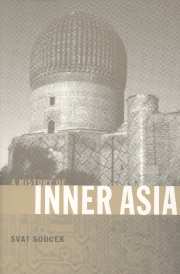Book contents
- Frontmatter
- Contents
- List of maps
- Preface
- Introduction
- 1 The beginnings
- 2 The Kök Turks, the Chinese expansion, and the Arab conquest
- 3 The Samanids
- 4 The Uighur kingdom of Qocho
- 5 The Qarakhanids
- 6 Seljukids and Ghaznavids
- 7 The conquering Mongols
- 8 The Chaghatayids
- 9 Timur and the Timurids
- 10 The last Timurids and the first Uzbeks
- 11 The Shaybanids
- 12 The rise of Russia, the fall of the Golden Horde, and the resilient Chaghatayids
- 13 The Buddhist Mongols
- 14 Bukhara, Khiva, and Khoqand in the seventeenth to nineteenth centuries
- 15 The Russian conquest and rule of Central Asia
- 16 From Governorates-General to Union Republics
- 17 Soviet Central Asia
- 18 Central Asia becomes independent
- 19 Sinkiang as part of China
- 20 Independent Central Asian Republics
- 21 The Republic of Mongolia
- Summary and conclusion
- Appendix 1 Dynastic tables
- Appendix 2 Country data
- Select bibliography
- Index
Introduction
Published online by Cambridge University Press: 05 June 2012
- Frontmatter
- Contents
- List of maps
- Preface
- Introduction
- 1 The beginnings
- 2 The Kök Turks, the Chinese expansion, and the Arab conquest
- 3 The Samanids
- 4 The Uighur kingdom of Qocho
- 5 The Qarakhanids
- 6 Seljukids and Ghaznavids
- 7 The conquering Mongols
- 8 The Chaghatayids
- 9 Timur and the Timurids
- 10 The last Timurids and the first Uzbeks
- 11 The Shaybanids
- 12 The rise of Russia, the fall of the Golden Horde, and the resilient Chaghatayids
- 13 The Buddhist Mongols
- 14 Bukhara, Khiva, and Khoqand in the seventeenth to nineteenth centuries
- 15 The Russian conquest and rule of Central Asia
- 16 From Governorates-General to Union Republics
- 17 Soviet Central Asia
- 18 Central Asia becomes independent
- 19 Sinkiang as part of China
- 20 Independent Central Asian Republics
- 21 The Republic of Mongolia
- Summary and conclusion
- Appendix 1 Dynastic tables
- Appendix 2 Country data
- Select bibliography
- Index
Summary
NATURAL SETTING
Inner Asia is marked by three distinct features: (1) a belt of steppes and, to a lesser degree, deserts, which extend in a general latitudinal direction. This belt is delimited on the north by the Eurasian forest zone (the “taiga” of Siberia); on the south the limits are a variety of features, chiefly mountain chains but also transition to different climatic zones (notably in China) and bodies of water such as the Caspian and Black Seas; (2) several of these mostly latitudinal mountain chains that separate the steppe belt from South Asia, besides demarcating important segments within the area; and (3) a number of rivers, many of which drain into interior lakes or seas or disappear in the deserts through evaporation. All these features have affected the type and history of human presence, but some have in turn been modified by man's intervention, since the dawn of sedentary civilization but especially in recent decades.
The steppe belt, an immense swath of landlocked grassland, made possible the appearance of a unique historical phenomenon: the horse-breeding, highly mobile Eurasian nomad. To be sure, nomads have also existed in other parts of the world, but the scale of the habitat, the role of the horse, and the relative and paradoxical proximity of great agricultural or urban civilizations made it possible for the Inner Asian nomad to play a historical role as unique and often as grandiose as was his homeland.
- Type
- Chapter
- Information
- A History of Inner Asia , pp. 1 - 45Publisher: Cambridge University PressPrint publication year: 2000



